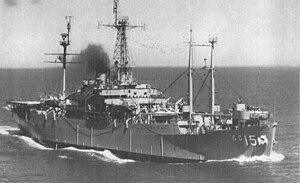USS Adirondack (AGC-15)
 |
|
| History | |
|---|---|
| Name: | USS Adirondack |
| Builder: | North Carolina Shipbuilding Company, Wilmington, North Carolina |
| Laid down: | 18 November 1944 |
| Launched: | 13 January 1945 |
| Commissioned: | 2 September 1945 |
| Decommissioned: | 9 November 1955 |
| Struck: | 1 June 1961 |
| Fate: | Sold for scrap, 7 November 1972 |
| General characteristics | |
| Class and type: | Adirondack-class command ship |
| Displacement: |
|
| Length: | 459 ft 2 in (139.95 m) |
| Beam: | 63 ft (19 m) |
| Draft: | 24 ft (7.3 m) |
| Propulsion: | Geared turbine, 1 shaft, 6,000 shp (4,474 kW) |
| Speed: | 16 knots (30 km/h; 18 mph) |
| Complement: | 633 officers and enlisted |
| Armament: |
|
The third USS Adirondack (AGC-15) was laid down on 18 November 1944 under a Maritime Commission contract by the North Carolina Shipbuilding Company in Wilmington, North Carolina; launched on 13 January 1945, sponsored by Mrs. E. L. White; transferred to the Navy on 4 February 1945; towed to the Philadelphia Naval Shipyard for conversion; and commissioned on 2 September 1945, the day Japan surrendered on board the battleship Missouri (BB-63) in Tokyo Bay, with Captain R. O. Myers in command.
The ship was designed as an amphibious force flagship, a floating command post with advanced communications equipment and extensive combat information spaces to be used by the amphibious forces commander and landing force commander during large-scale operations. After shakedown training in the Chesapeake Bay from 25 September to 12 October 1945, Adirondack assumed the duties of flagship for Commander, Operational Development Force (CTF 69), and operated out of Norfolk until August 1949, when she was scheduled to participate in an Antarctic expedition. However, that project was cancelled, and Adirondack reported to the Philadelphia Naval Shipyard for inactivation. On 1 February 1950, she was placed in reserve, in service, as flagship of the Philadelphia Group, Atlantic Reserve Fleet.
Over a year later, the command ship returned to the active fleet. Following a recommissioning ceremony in Philadelphia on 4 April 1951, Adirondack reported to the Atlantic Fleet Training Command in Norfolk, Virginia, for inspection and training. She returned to Philadelphia on 3 June to complete final preparations for a tour in the Mediterranean as flagship for the Commander in Chief, Allied Forces in southern Europe (CINCSOUTH), and for the Commander in Chief, U.S. Naval Forces, Northeastern Atlantic and Mediterranean Fleets (CINCNELM).
...
Wikipedia
